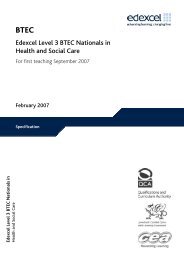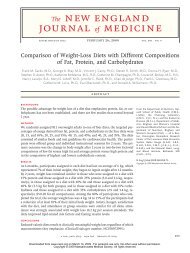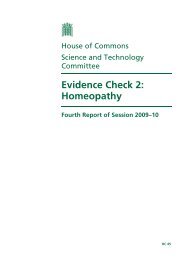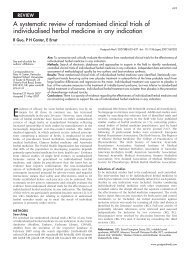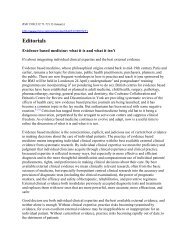German Acupuncture Trials (GERAC) for Chronic Low Back Pain
German Acupuncture Trials (GERAC) for Chronic Low Back Pain
German Acupuncture Trials (GERAC) for Chronic Low Back Pain
Create successful ePaper yourself
Turn your PDF publications into a flip-book with our unique Google optimized e-Paper software.
Patient consent <strong>for</strong> participation<br />
Physician checks eligibility criteria<br />
Patient receives questionnaires;<br />
physician reports patient to central<br />
data center using a fax<br />
–17 d<br />
Screening<br />
Primary contact<br />
interview<br />
∆ = 14 Days be<strong>for</strong>e baseline interview<br />
Physiotherapies were supported by nonsteroidal antiinflammatory<br />
drugs or pain medication up to the maximum<br />
daily dose during the therapy period. Rescue medication was<br />
identical to that <strong>for</strong> the acupuncture groups.<br />
During acupuncture treatment, communication with the patient<br />
was limited to necessary explanations to avoid unblinding<br />
the patient by suggestive remarks. Patients in all 3 groups<br />
were in<strong>for</strong>med be<strong>for</strong>e randomization that acupuncture would<br />
be offered after completion of the trial.<br />
OUTCOME MEASURES<br />
Baseline interview<br />
plus primary<br />
outcome measure<br />
–3 d<br />
Baseline Phase<br />
Telephone interviews by trained employees of the study center<br />
were conducted at baseline and at 1 1 ⁄2, 3, and 6 months. Our primary<br />
outcome was treatment response 6 months after randomization,<br />
defined as 33% improvement or better on 3 pain-related<br />
itemsontheVonKorff<strong>Chronic</strong><strong>Pain</strong>GradeScale 7 or12%improvement<br />
or better on back-specific functional status measured by the<br />
Hanover Functional Ability Questionnaire. 8 Patients who had recourse<br />
to additional treatments other than rescue medication were<br />
classified as nonresponders, as were unblinded patients.<br />
Secondary outcomes were responder rate at 1 1 ⁄2 and 3 months<br />
after randomization, scores on the 12-item Short Form Health<br />
Survey, 12 and patient global assessment of therapy effectiveness<br />
on a scale of 1 (very good) to 6 (fail). 13 Physicians documented<br />
medication use, acupuncture treatment, and adverse events at<br />
each session and at the final examination after 6 months. Patient<br />
blinding was assessed at the 6-month interview by asking<br />
whether their physician had in<strong>for</strong>med them of their allocation<br />
and, if not, by asking the method of acupuncture and how certain<br />
they were of their response. 14 All interview questions were<br />
given to the patients during the baseline visit.<br />
RANDOMIZATION AND BLINDING<br />
Rechecking of<br />
eligibility criteria<br />
The 1:1:1 randomization was per<strong>for</strong>med dynamically by a computer<br />
program balancing <strong>for</strong> 2 levels of chronification (�2 or<br />
�2 years), 2 levels of fear avoidance belief 15 (�4or�4 average<br />
total points), 2 levels of activity (�60 or �60 minutes), patient<br />
expectations, 16 and trial center. The previous allocation scheme<br />
and a prespecified list of random numbers were used. After successful<br />
completion of the baseline interview and once the patient<br />
had come <strong>for</strong> the first treatment, the physician called a randomization<br />
hotline that registered the patient in the study and<br />
faxed the patient’s assigned treatment group to the physician.<br />
Patients were blinded to the type of acupuncture. They were<br />
told they would be treated with a traditional Chinese <strong>for</strong>m of<br />
Physician receives<br />
result of randomization<br />
from data center<br />
Start of treatment<br />
Figure 2. Study design <strong>for</strong> <strong>German</strong> <strong>Acupuncture</strong> Trial <strong>for</strong> <strong>Chronic</strong> <strong>Low</strong>er <strong>Back</strong> <strong>Pain</strong>. Adapted from Endres et al. 9<br />
Treatment extension<br />
(5 sessions)<br />
Telephone interviews<br />
acupuncture (verum), with a <strong>for</strong>m of acupuncture developed<br />
especially <strong>for</strong> this study (sham), or with conventional therapy.<br />
Investigators could not be blinded to the method of acupuncture,<br />
but the interviewers were.<br />
STATISTICAL ANALYSIS<br />
The primary analysis included all randomized patients on the<br />
intent-to-treat basis. Patients in all groups who missed the<br />
6-month-assessment were, there<strong>for</strong>e, classified as nonresponders.<br />
Response rates were tested <strong>for</strong> differences using the<br />
2-sided Fisher exact test. The multiple testing problem caused<br />
by the comparison of 3 treatment methods was handled by a<br />
closed test procedure to guarantee the type I error level of 5%<br />
<strong>for</strong> all pairwise comparisons. Two tests comparing verum acupuncture<br />
with the 2 control groups at a level of 2.5% each were<br />
per<strong>for</strong>med as a first step. 6 If this global test ruled out the null<br />
hypothesis of no difference among the 3 treatments, then all 3<br />
pairwise comparisons were per<strong>for</strong>med at a level of 5%. The study<br />
was powered to detect a change of 10% in response rates (verum<br />
acupuncture, 60%; conventional therapy, 50%; and sham acupuncture,<br />
40%), with 95% power <strong>for</strong> the global test. Assuming<br />
a 30% dropout rate, this led to a required sample size of<br />
354 patients per group. Exploratory analyses were per<strong>for</strong>med<br />
<strong>for</strong> all secondary end points. Sensitivity analyses included comparisons<br />
with grouping by treatment, dropping patients who<br />
missed the 6-month assessment, and best and worst imputation<br />
of missing data at 6-month assessment in all pairwise comparisons.<br />
RESULTS<br />
PARTICIPANTS<br />
Primary outcome<br />
measure<br />
0<br />
42 d<br />
90 d 180 d<br />
Treatment Phase<br />
10 Sessions<br />
Overall, 1802 patients with low back pain were screened,<br />
and 1162 were randomized between March 7, 2002 (first<br />
randomization), and December 12, 2004 (last randomization)<br />
(Figure 1). The primary reason <strong>for</strong> nonrandomization<br />
was insufficient severity of disability as measured<br />
with the Hanover Functional Ability Questionnaire.<br />
One patient dropped out because of pregnancy and was<br />
excluded from the primary analysis. Twenty-three patients<br />
in the intent-to-treat population in the conventional<br />
therapy group missed the 6-month telephone assessment<br />
and were, thus, classified as nonresponders. They<br />
(REPRINTED) ARCH INTERN MED/ VOL 167 (NO. 17), SEP 24, 2007 WWW.ARCHINTERNMED.COM<br />
1894<br />
Downloaded from<br />
www.archinternmed.com at University College London, on September 25, 2007<br />
©2007 American Medical Association. All rights reserved.



